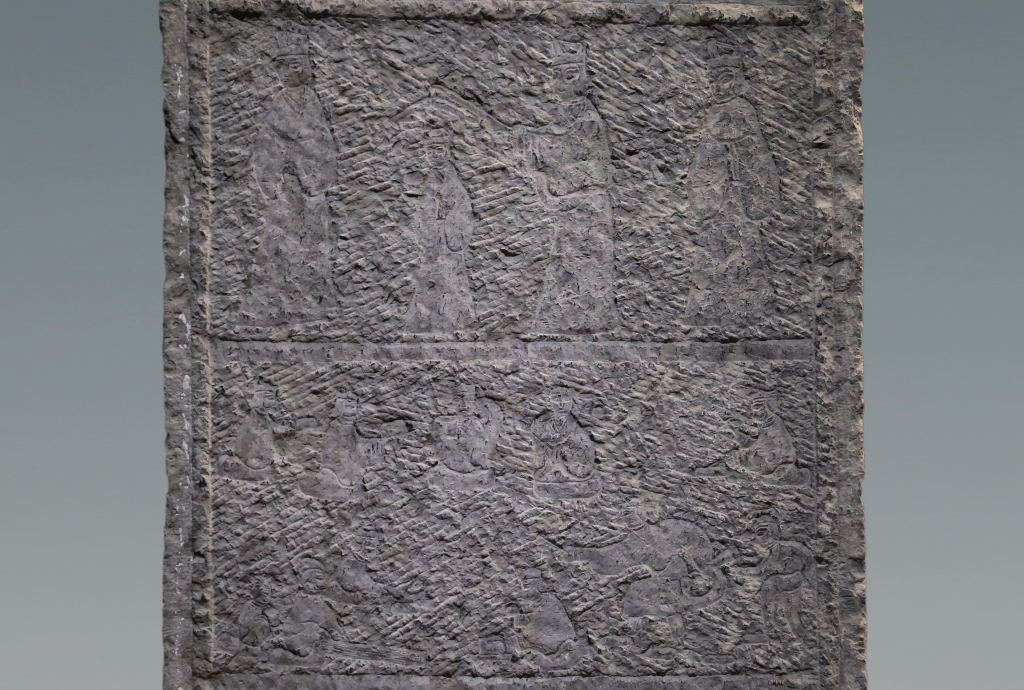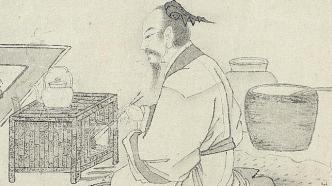
"Heaven, time, personnel, and the day remind each other, and the winter solstice is born and spring comes again." The twenty-ninth winter month of the lunar calendar is the winter solstice.
The winter solstice is a sign of entering the depths of winter. In this increasingly cold solar term, it is most appropriate to invite a few friends to make tea around the stove.
"Cooking tea around the furnace" has existed in ancient times. Su Dongpo has a sentence of "red roasted shallow Ou with new fire, dragon balls with small mills and buckets to clear the window". The fire is red at the beginning. It is the same as usual, and the moon in front of the window is different." In ancient calligraphy and painting, there are also many masterpieces of tea brewing around the stove, such as Liu Songnian's "Picture of Chasing Tea", tea whisks, celadon tea cups, and red lacquer saucers , tortoiseshell tea powder boxes, etc. are not left behind, the stove in front of the table, the fire is blazing, and the lifting beam is placed on it to boil water; Ming and Tang Yin's "Tea Tasting Picture" axis, the owner sits in front of the desk and reads, and a child squats in the corner of the room Ding Yunpeng's "Yuchuan Boiling Tea Picture" axis is a fine brushwork painting created in his later years. In the painting, Lu Tong, a famous Tang Dynasty scholar, is staring at the tea stove on the fire intently, and his expression of concentration is depicted in detail.
In this cold winter season, "The Paper·Ancient Art" sorts out the paintings of "making tea around the stove" in the collection of the National Palace Museum and the National Palace Museum in Taipei for readers.
Scroll of Song Liu Songnian Chasing Tea

Song Dynasty Liu Songnian Pushing Tea Picture Scroll Collection of National Palace Museum, Taipei

Axis of Song Liu Songnian Pushing Tea (partial) Collection of National Palace Museum, Taipei
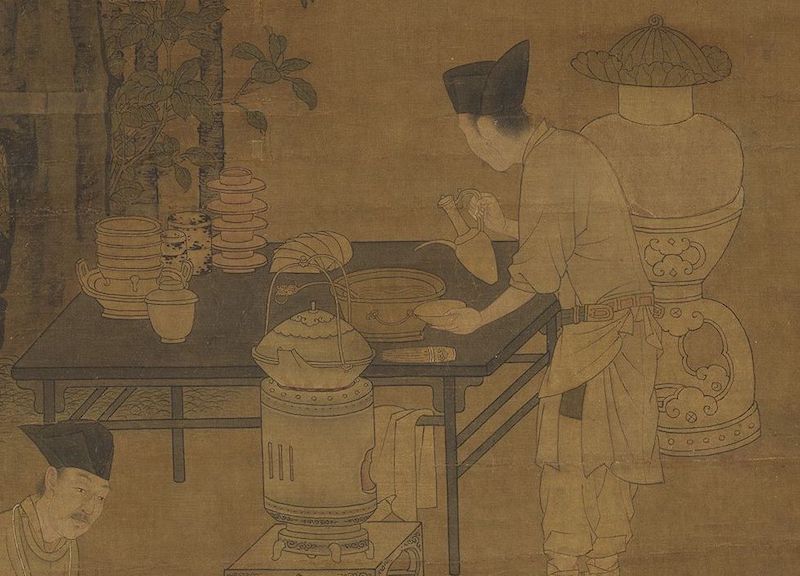
Axis of Song Liu Songnian Pushing Tea (partial) Collection of National Palace Museum, Taipei
Liu Songnian (active in 1174-1224), a native of Qiantang, Zhejiang, worked in the Academy of Painting during the period from Xiaozong to Lizong in the Southern Song Dynasty. The painting presents the method of ordering tea in the Song Dynasty. The picture on the left shows two waiters preparing tea. One of them sits astride a low table and pushes the tea through a tea grinder. A brown tea broom and whisk are placed on the side to gather the tea powder. The other person is standing by the table, holding a teacup on the left and a tea bottle on the right, and is ordering tea. On the tea table are tea whisks, celadon tea bowls, red lacquer saucers, tortoise shell tea powder boxes, etc. In front of the table is the stove, the fire is blazing, and there is a lifting beam on top to boil water.
Axis of Song Huizong Wenhui
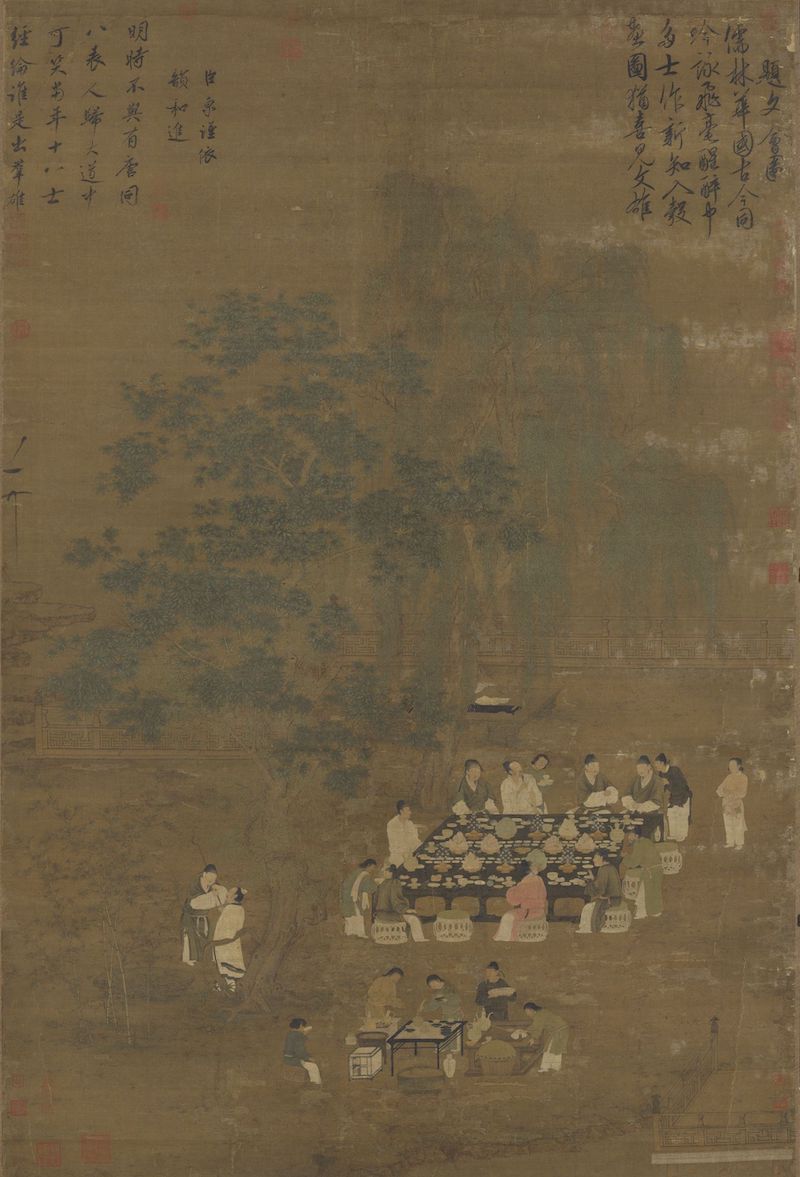
Emperor Huizong of the Song Dynasty (Style) Collection of the National Palace Museum, Taipei
Emperor Huizong of Song Dynasty (1082-1135 AD), surnamed Zhao Mingji, was good at painting and calligraphy, and had a very high level of Fu. The landscape, flowers, birds and figures are all beautiful and elegant.
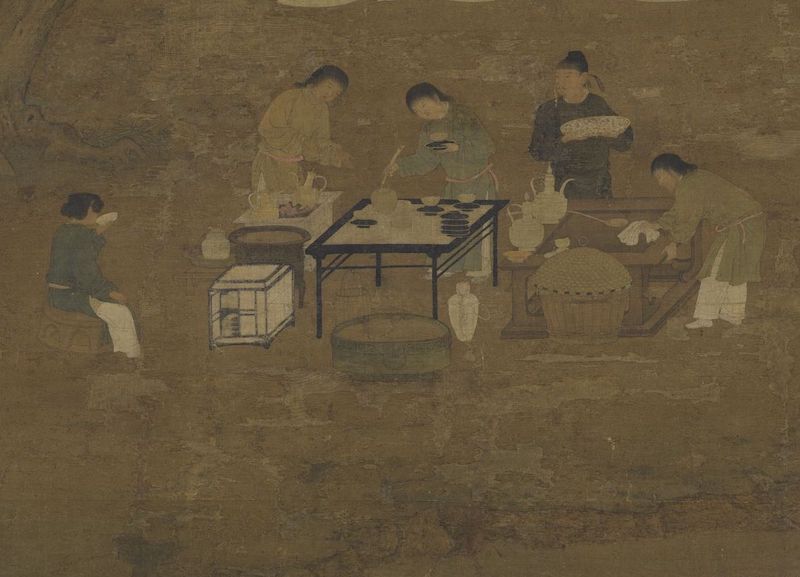
Emperor Huizong of Song Dynasty (Style) Wenhui Map Axis (Partial) Collection of National Palace Museum, Taipei
This painting depicts a group of scribes having a banquet under the big tree by the pool. There are servants preparing tea on a small table in front, and one of them is holding a long-handled spoon to scoop tea powder from the tea pot, following the "tea ordering method" that has been popular since the end of Tang Dynasty. The characters all have elegant and handsome expressions, and the folds of their clothes are strong and vivid. Bamboo trees are equipped with double hooks, and the pen is as thin and vigorous as a steel needle and iron, and it must be done with all its strength. The whole handwriting is intricate and intricate, and there is no slack in the writing, which is extremely delicate and capable. This painting depicts extremely gorgeous garden utensils. It is different from the simple background of the Wenhui map of the Five Dynasties. The Wenhui map of the Northern Song Dynasty is placed in a complete garden scene, which also reflects the development of gardens in the Northern Song Dynasty. Although there is a poem inscribed by Huizong on the upper right of this picture, his painting inscribed on the middle left, and a poem inscribed by Cai Jing on the upper left, they are all suspicious and should be the work of a famous artist in the painting academy.
Song Dynasty Qianxuan (pattern) Painting axis of Lu Tong cooking tea

Song Dynasty Qianxuan (Paint) Painting Lu Tong Cooking Tea Scroll Collection of the National Palace Museum, Taipei

Song Dynasty Qianxuan (Paint) Axis of Painting Lu Tong Cooking Tea (Partial) Collection of National Palace Museum, Taipei
Qian Xuan (approximately 1235-1307), courtesy name Shunju and nickname Yutan, was born in Wuxing, Zhejiang. He was a famous painter in the late Song Dynasty and early Yuan Dynasty. This painting has bright colors and fine strokes. The tea vessel in the painting uses Zhuni Yixing teapot to cook tea, which is the method of making leaf tea after the middle of Ming Dynasty. Three people in the painting cook tea with a single-handle pot on top of the stove, and a double-layered vermilion mud teapot beside it; the white-clothed scholar on the front is Lu Tong (about 795-835), a poet of the Tang Dynasty, and beside him is a tripod Red clay teapots, white porcelain tea pots, red lacquer saucers, calligraphy and painting albums, etc., reflect the hermit life of literati gathering together to drink tea and discuss books.
Song Dynasty Liu Songnian (mark) Tea Fighting Axis
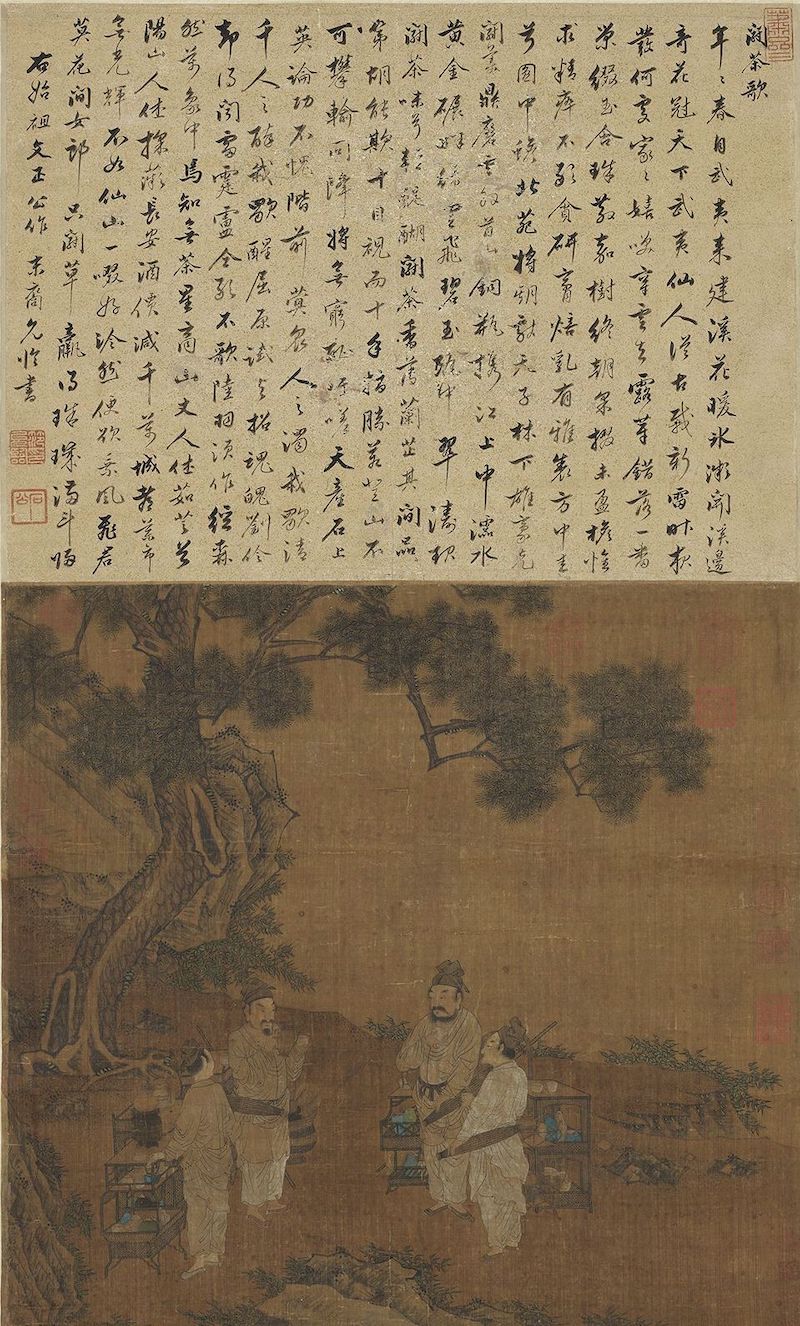
Song Dynasty Liu Songnian (pattern) Tea Fighting Scroll, Taipei National Palace Museum Collection
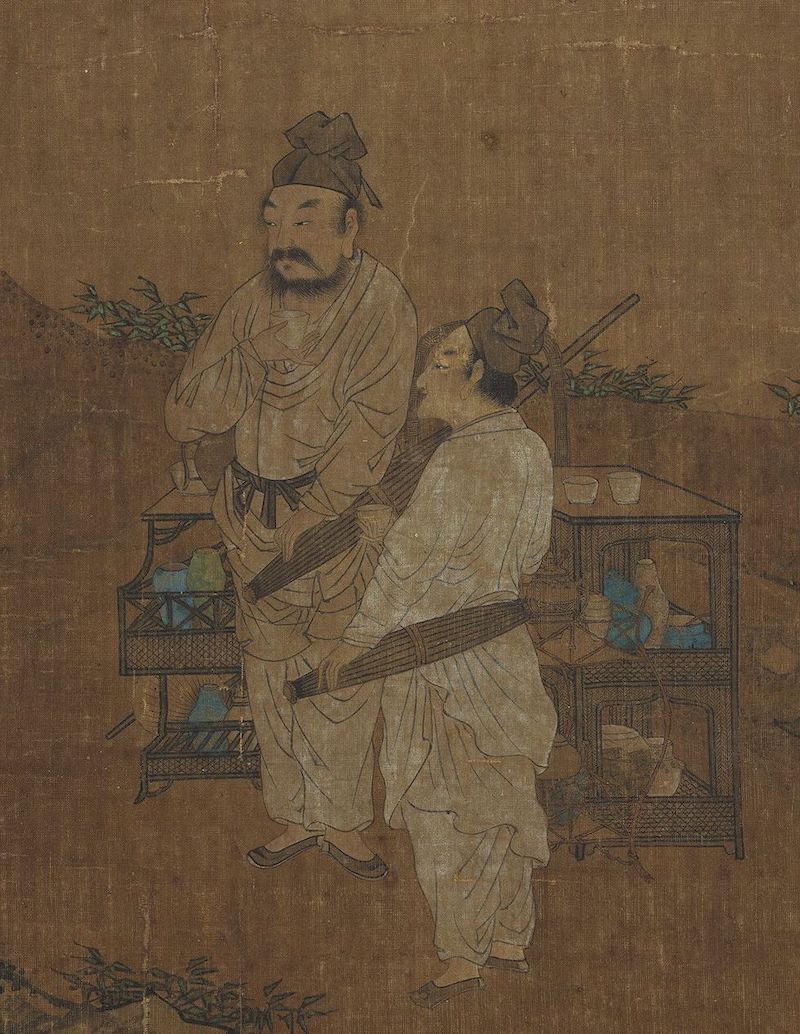
Song Dynasty Liu Songnian (type) Axis of Fighting Tea (partial) Collection of National Palace Museum, Taipei
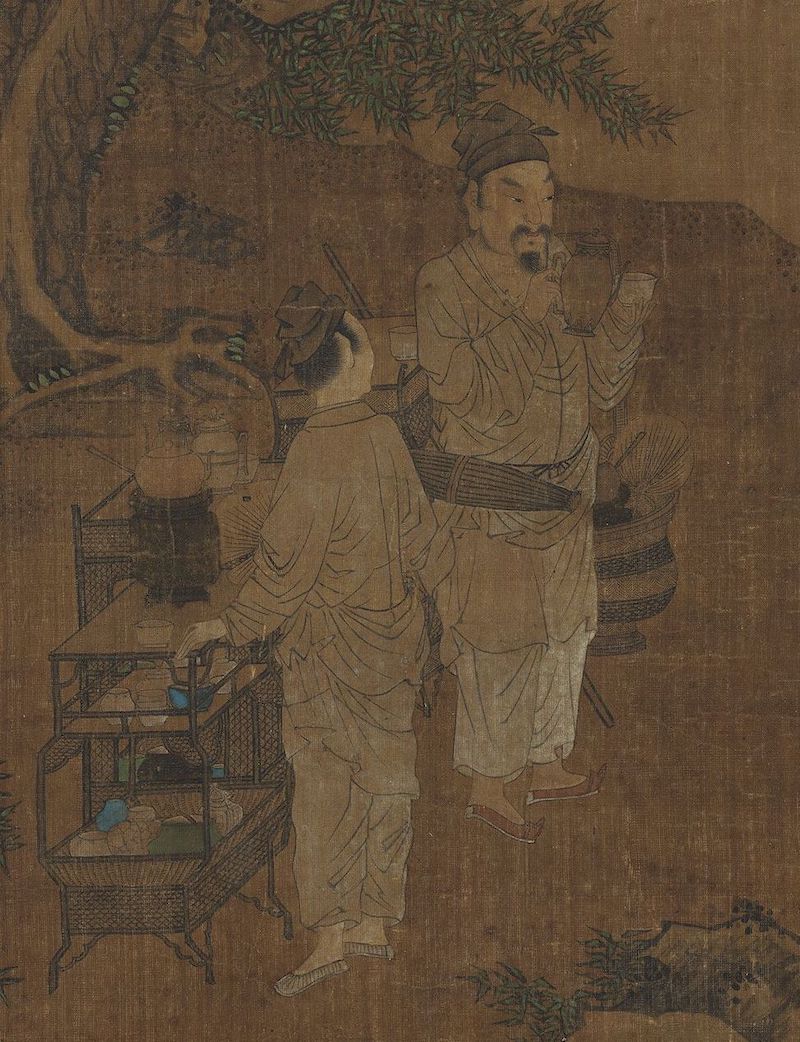
Song Dynasty Liu Songnian (type) Axis of Fighting Tea (partial) Collection of National Palace Museum, Taipei
The Song Dynasty was an era that paid great attention to tea ceremony, from the emperor to the scholar-bureaucrats, there was nothing wrong with it. Song Huizong Zhao Ji wrote "Grand View Tea Theory", Cai Xiang wrote "Tea Record", Huang Ru wrote "Tea Tasting Yaolu", some literati and scholars were more popular with the life interest of fighting tea, and the wind of tea fighting was very prosperous in Song Dynasty. This painting has the inscription "Song of Fighting Tea" in running script by Fan Yunlin (1558-1641), an official and calligrapher of the Ming Dynasty.
Axis of Ming Dynasty Tea Tasting Picture

Ming Wen Zhengming Tea Tasting Picture Axis Collection of the National Palace Museum, Taipei
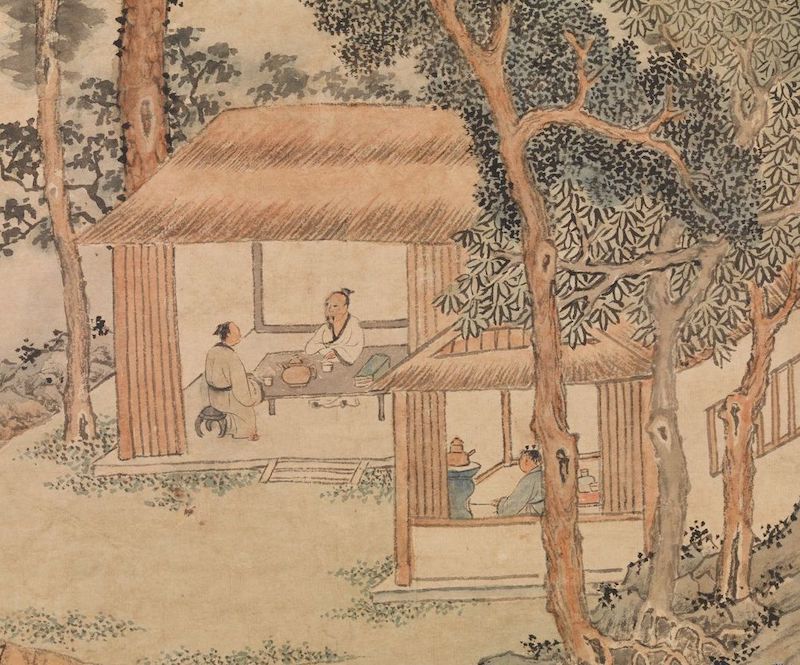
Axis of Tasting Tea in Ming Dynasty (partial) Collection of National Palace Museum, Taipei
Wen Zhengming was born in a family of literati, and spent most of his life traveling in the mountains and forests, pursuing nature. Most of the works are portrayals of life. He was addicted to tea all his life, and once said to himself: "I don't drink alcohol in my life, but I am also drunk with tea." He used tea in poetry, painting, and calligraphy. The literati tasting tea in the paintings are also quite representative. This picture depicts a scene of drinking tea with friends before the rain. In the thatched cottage with an elegant environment, the two sit opposite each other drinking tea and chatting, with tea pots and tea bowls on the table; one person outside the hall is walking across the bridge. In the teahouse, a boy fanned the fire to boil the spring and prepared the tea ceremony. A small literati tea party was about to begin.
Axis of Yin Tasting Tea in Ming and Tang Dynasties
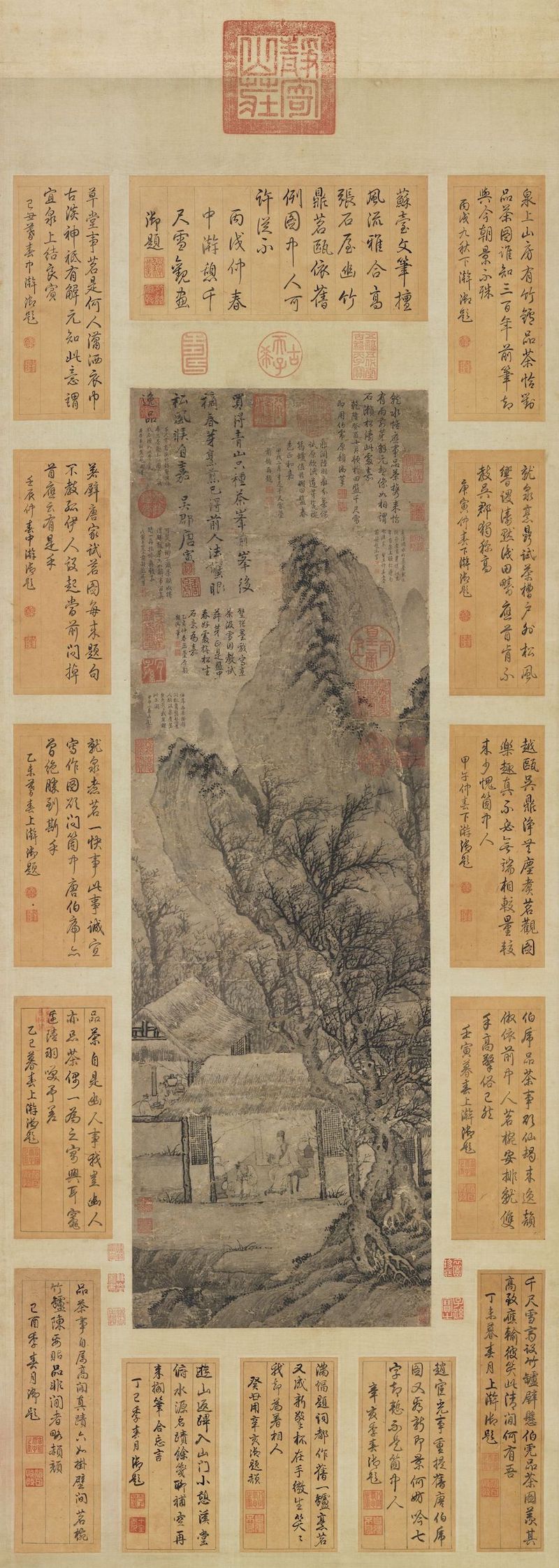
Ming and Tang Dynasties Tasting Tea Scroll, National Palace Museum, Taipei

Axis of Yin Tasting Tea in Ming and Tang Dynasties (partial) Collection of National Palace Museum, Taipei
This painting has Tang Yin's own title in running script: Buy green hills only grow tea, pick spring buds in front of the peak and behind the peak. Cooking and frying have been done by predecessors, and crab eyes and pines are self-satisfactory. Tang Yin of Wu County.

Axis of Yin Tasting Tea in Ming and Tang Dynasties (partial) Collection of National Palace Museum, Taipei
Tang Yin (1470-1523), courtesy name Bohu, was born in Wu County, Jiangsu Province. Together with Shen Zhou, Wen Zhengming and Qiu Ying, he was known as the Four Great Masters of the Ming Dynasty. This picture depicts the scene of literati reading and tasting tea in winter. There are three couplets in the thatched house in the cold forest. The owner sits in front of the desk and reads, and a child squats in the corner of the house, fanning the fire to boil the spring; there are teapots and tea pots on the tables in the side room, presenting the leisurely mountain life of literati as a whole. "Tea Tasting Picture" is a treasure displayed by Emperor Qianlong on the wall of the "Thousand Chixue" tea house in Jingji Mountain Villa, Panshan, Hebei. On the painting, there are poems written by Qianlong every time he stays and the seal of "Jingji Mountain Villa".
Ming Ding Yunpeng Yuchuan Brewing Tea Scroll

Ming Ding Yunpeng Yuchuan Tea Brewing Axis Collection of the Palace Museum
The inscription is "Tea Brewing Picture in Yuchuan. Renzi Dongri wrote for Mr. Xunzhi in Huqiu Sengliao, Ding Yunpeng", with "Yunpeng" Zhu Wenyin and "Nanyu" Zhu Wenyin. In addition, there are "Three Sons Capital Foreign Ministers" Bai Wenyin, "Shen Shuyong Seal" Bai Wenyin, and "Yun Chu Approved" Zhu Wenyin. Renzi is the 40th year of Wanli (1612).
The picture depicts the scene of Lu Tong, a famous scholar in the Tang Dynasty, making tea. It is a meticulous painting created by Ding Yunpeng in his later years. Lu Tong (approximately 796-835), a native of Jiyuan, was originally from Fanyang (now Zhuozhou, Hebei). He lived in seclusion in Shaoshi Mountain in his early years. He is excellent in both poetry and prose. He once wrote "Moon Eclipse Poem" to stab current politics, which was praised by Han Yu. He is good at drinking tea, and there are many strange sentences in his "Tea Song". On the screen, Lu Tong is dressed in casual clothes, wearing a scarf on his head, holding a lupine, sitting cross-legged on the bluestone in front of the plantain, with strange rocks behind him and green bamboos, and two servants are waiting beside him. Lu Tong stared intently at the tea stove on the fire, his engrossed expression was depicted in detail. The flowers, bamboo, and plantains in the picture are neatly depicted, the yin and yang of the strange rocks, and the textures are clearly explained, the colors are light and cool, and the green is dripping. The clothing patterns of the characters are drawn with elegant and unrestrained ancient gossamer silk, or drawn with round and thin iron lines to distinguish different textures of clothing materials and show the artist's ingenuity. The painting techniques of the whole picture are diverse and the style is unified. The expressions of the characters are vivid, the trees and rocks are full of vitality, and the brushwork is like flowing clouds and flowing water, which is detached and outstanding.
King Ming asked about making tea
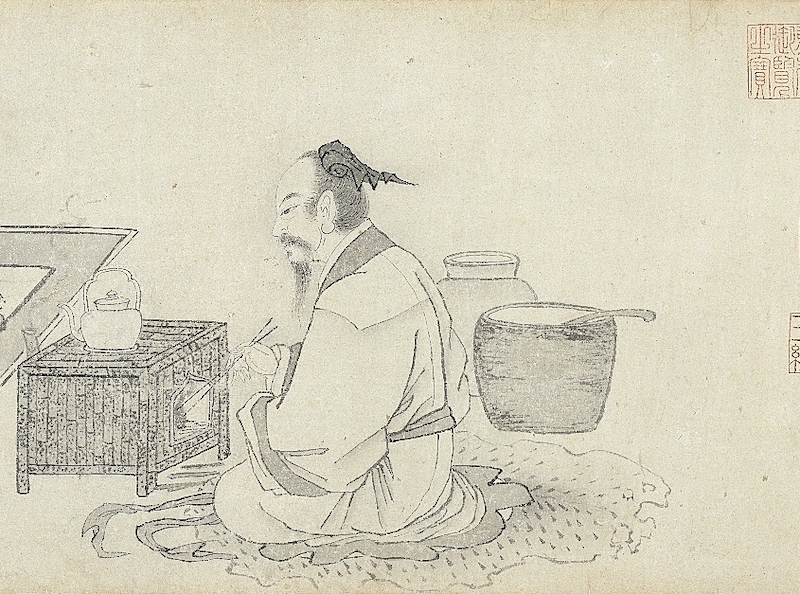
The King of Ming Asks About Making Tea Scroll Collection of the National Palace Museum, Taipei

King Ming asked about making tea (partial) Collection of National Palace Museum, Taipei
Wang Wen (1497-1576), styled Ziyu, was born in Wuxi, Jiangsu. A literati painter in the mid-Ming Dynasty. This scroll was painted in the thirty-seventh year of Jiajing (1558), and it is drawn purely with lines. The master on the left is cooking tea with charcoal in front of the bamboo pot, and the teapot is placed on it; There are pens, inkstones, incense burners, scrolls, etc. on the table. The whole presents the elegant and leisurely life of literati gathering, discussing books and drinking tea, filled with the fragrance of books and tea, which is one of the common themes in tea paintings in the late Ming Dynasty.
Atlas of Yinzhen's Pleasure in the Qing Dynasty · Viewing Book Pages Around the Furnace

Atlas of Yinzhen's Pleasure in the Qing Dynasty·While Looking Around the Fireplace Book Pages Collection of the Palace Museum
This picture is one of sixteen pages. The picture depicts Yinzhen (Prince Yong) dressed in Han literati costumes, holding a book in his hand and concentrating on reading, with a steaming stove under his feet. The most eye-catching thing in the painting is the treasure chest on the left, which contains ancient Yi wares, rare books, calligraphy and painting hand scrolls, which are favored by literati and refined scholars. This shows the elegant taste of the protagonist; the tea set and food box on the right of the picture allude to Yinzhen At this point in a state of comfort and relaxation. The plum blossoms blooming against the cold outside the gate not only show the extraordinary taste of the owner, but also reflect the warmth and comfort inside the small warm pavilion.
The whole picture is neat and precise, with bright colors and unique conception. This picture is in line with the artistic conception of "Mountain Dwelling Narratives" in the second volume of "Yue Xin Ji" Luo Dajing: "The courtyard is full of snow, the courtyard is full of moon, and a pine fire is warming. After reading the medical books, read the alchemy scriptures." From this painting, we can see Yinzhen's yearning for the leisurely life of elegant scholars and his aesthetic taste of elegance and elegance.
(This article is compiled from relevant materials of the Palace Museum and Taipei Palace Museum.)


